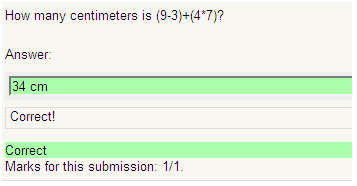These questions look very similar to Short Answer questions. The only difference is that these items allow for a bit of variation in the numerical responses. Let's look at how to make one.
We are going to create a new test titled Numerical. We will change the category to Default for Numerical and then make a new Numerical question.
Tip
A Note on Categories
I am separating questions into distinct categories here; this may or may not be how you want to do it. I am doing using categories to keep all the questions in separate places for demonstration purposes. This style may not be appropriate for you and your situation.
Our question will be about area, and just for fun, we are going to add an image to the question. Once the question is created, title it What is the area of the rectangle shown?. In the Question text, enter the same thing.
Do you remember how to upload an image? Place your cursor in the appropriate place in the rich-text editor of the question text. Click on the image icon in the taskbar and the Insert Image menu will appear. We are going to take an image of a rectangle and upload it to the image folder. Once the image is there, we need to give it an Alternative Text; I'm calling mine Rectangle. Once these steps have been completed, we click on the OK button and the image will be placed in the Question HTML editor.
Now we will scroll down to the Answer section. These items look very similar to the Short Answer items, except each has what is called an Accepted Error textbox.
The Accepted Error textbox allows us to set a range of numbers that we will accept as correct. By entering a number in this textbox, we are giving a ± range of whatever number we enter in the box as correct. For example, if I have an answer of 50 and the Accepted Error is five, any number between 45 and 55 would be deemed correct and receive the full points for the question. If the Accepted Error is filled with a 0 or left empty, there will be no accepted variations in the answer.
We will now enter the correct answer in the Answer textbox. Our rectangle is 5 by 6, so our Answer is 30. This answer is worth full points, so we will make Grade 100 percent. We will not accept any variation on this response, so we will enter a 0 in the Accepted Error textbox. For feedback, we will enter Well done!.
For any other answer, we want to give incorrect feedback, so we will use the wildcard as in Short Answer and place an * in Answer 2, leaving the grade as None, and the Accepted Error blank. Once these steps are complete, click on the Save changes button.
Now that our question has been created, we want to preview it. Click on the Preview icon and we see the following screenshot:

Two additional, and important, features of Numerical questions are the abilities to use units and multipliers.
You might want to use units of measurement in your response. If so, we need to enter the unit we want to use in the Unit textbox. For example, if you enter a unit of cm here, and the accepted answer is 15, then the answers 15cm and 15 are both accepted as correct. It is important to also note that if a unit is entered, the unit used in the answer must be identical. For example, if you entered GDP and a student entered G.D.P., it would be marked incorrect.
You can also specify a multiplier. This multiplier will help convert from one unit to another. So, if your main answer was 5500 with unit W, you can also add the unit kW with a multiplier of 0.001. This means that the answers 5500, 5500W or 5.5kW would all be marked correct. Note that the accepted error is also multiplied, so an allowed error of 100W would become an error of 0.1kW.
That is all there is to making a simple, Numerical item in Quiz.
Now you are going to create a numerical item. Carry out the following steps and you shouldn't have any problems. If you do, go back to the Numerical section and look it over.
Make sure you are in the Default for Numerical category and create a new Numerical question.
- For Question name and Question text enter How many centimeters is (9-3)+(4*7)?.
- In the Answer 1 Answer textbox, enter 34, give the Grade as 100 percent, and leave Accepted Error blank. In Feedback, enter Correct!.
- In the Answer 2 Answer textbox, enter *, leave the grade as None, and leave Accepted Error blank. In feedback, enter Sorry. Check your work again!.
- Scroll down to Unit 1 and in the Unit textbox enter cm.
- Save the question and preview it. Enter the correct answer and you should see the screenshot shown below. The incorrect answer will display the wildcard message.

There are many uses for these questions and they are a valuable addition to the Quiz repertoire. There are two small things that need to be considered before using these items.
If you are interested in having an equation like (x+4)*y=?, you can do so by entering the variables in the HTML editor as part of the question. However, because this question type does not allow for variables, it may be better to use the Calculated item type described later in this chapter.
Another issue to consider is word problems. You are not able to enter words as answers in Numerical questions, so if you are interested in creating word problems, you will want to use the Short Answer question.
